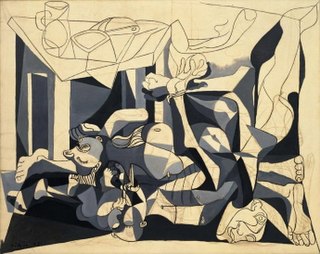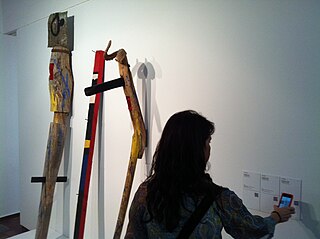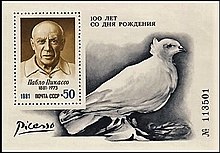
Georges Braque was a major 20th-century French painter, collagist, draughtsman, printmaker and sculptor. His most notable contributions were in his alliance with Fauvism from 1905, and the role he played in the development of Cubism. Braque's work between 1908 and 1912 is closely associated with that of his colleague Pablo Picasso. Their respective Cubist works were indistinguishable for many years, yet the quiet nature of Braque was partially eclipsed by the fame and notoriety of Picasso.

Lithography is a planographic method of printing originally based on the immiscibility of oil and water. The printing is from a stone or a metal plate with a smooth surface. It was invented in 1796 by the German author and actor Alois Senefelder and was initially used mostly for musical scores and maps. Lithography can be used to print text or images onto paper or other suitable material. A lithograph is something printed by lithography, but this term is only used for fine art prints and some other, mostly older, types of printed matter, not for those made by modern commercial lithography.

Pablo Ruiz Picasso was a Spanish painter, sculptor, printmaker, ceramicist and theatre designer who spent most of his adult life in France. One of the most influential artists of the 20th century, he is known for co-founding the Cubist movement, the invention of constructed sculpture, the co-invention of collage, and for the wide variety of styles that he helped develop and explore. Among his most famous works are the proto-Cubist Les Demoiselles d'Avignon (1907) and the anti-war painting Guernica (1937), a dramatic portrayal of the bombing of Guernica by German and Italian air forces during the Spanish Civil War.

A number of peace symbols have been used many ways in various cultures and contexts. The dove and olive branch was used symbolically by early Christians and then eventually became a secular peace symbol, popularized by a Dove lithograph by Pablo Picasso after World War II. In the 1950s the "peace sign", as it is known today, was designed by Gerald Holtom as the logo for the British Campaign for Nuclear Disarmament (CND), a group at the forefront of the peace movement in the UK, and adopted by anti-war and counterculture activists in the US and elsewhere. The symbol is a superposition of the semaphore signals for the letters "N" and "D", taken to stand for "nuclear disarmament", while simultaneously acting as a reference to Goya's The Third of May 1808 (1814).
Events from the year 1937 in art.

Guernica is a large 1937 oil painting by Spanish artist Pablo Picasso. It is one of his best-known works, regarded by many art critics as the most moving and powerful anti-war painting in history. It is exhibited in the Museo Reina Sofía in Madrid.

Dance (La Danse) is a painting made by Henri Matisse in 1910, at the request of Russian businessman and art collector Sergei Shchukin, who bequeathed the large decorative panel to the Hermitage Museum in Saint Petersburg, Russia. The composition of dancing figures is commonly recognized as "a key point of (Matisse's) career and in the development of modern painting". A preliminary version of the work, sketched by Matisse in 1909 as a study for the work, resides at MoMA in New York City, where it has been labeled Dance (I).

The Weeping Woman is a series of oil on canvas paintings by Pablo Picasso, the last of which was created in late 1937. The paintings depict Dora Maar, Picasso's mistress and muse. The Weeping Woman paintings were produced by Picasso in response to the bombing of Guernica in the Spanish Civil War and are closely associated with the iconography in his painting Guernica. Picasso was intrigued with the subject of the weeping woman, and revisited the theme numerous times that year. The last version, created on 26 October 1937, was the most elaborate of the series, and has been housed in the collection of the Tate Modern in London since 1987. Another Weeping Woman painting is housed at the National Gallery of Victoria and was involved in a high-profile political art theft.

Doves, typically domestic pigeons white in plumage, are used in many settings as symbols of peace, freedom, or love. Doves appear in the symbolism of Judaism, Christianity, Islam and paganism, and of both military and pacifist groups.

Massacre in Korea is an expressionistic painting completed on 18 January 1951 by Pablo Picasso. Picasso's third anti-war painting after Guernica and The Charnel House, Massacre depicts a scene of a massacre of a group of naked women and children by a firing squad. It has been considered to be a condemnation of American intervention in the Korean War. The painting was exhibited in the Musée Picasso in Paris.
Mourlot Studios was a commercial print shop founded in 1852 by the Mourlot family and located in Paris, France. It was also known as Imprimerie Mourlot, Mourlot Freres and Atelier Mourlot. Founded by Francois Mourlot, it started off producing wallpaper. Later, his son Jules Mourlot would expand the business to handle the production of chocolate labels for companies such as Chocolat Poulain, as well as ledgers, maps and stationary. Starting in the 1920s, Jules' son, Fernand Mourlot, converted one of the locations into a studio dedicated to printing fine art lithography.

Fernand Mourlot, son of Jules Mourlot, was the director of Mourlot Studios and founder of Editions Mourlot.

Aldo Crommelynck was a Belgian master printmaker who made intaglio prints in collaboration with many important European and American artists of the 20th century. At the time of his death, The Guardian termed Crommelynck the 'pre-eminent' and 'the most celebrated printmaker of the second half of the 20th century.'

Le pigeon aux petit pois, sometimes referred to as Dove with green peas, is a 1911 oil on canvas painting by Pablo Picasso. It is an example of Picasso's Cubist works and has an estimated value of €23 million. The painting was one of five artworks stolen from the Musée d'Art Moderne de la Ville de Paris on 20 May 2010, which together are valued at €100 million. It has so far not been recovered and its whereabouts remain unknown.

The Charnel House is an unfinished 1944–1945 oil and charcoal on canvas painting by Spanish artist Pablo Picasso, which is purported to deal with the Nazi genocide of the Holocaust. The black and white 'grisaille' composition centres on a massed pile of corpses and was based primarily upon film and photographs of a slaughtered family during the Spanish Civil War. It is considered to be the second of three major anti-war Picassos, preceded by Guernica in 1937 and succeeded by Massacre in Korea in 1951. The painting is housed in the Museum of Modern Art in New York City.

Joan Miró: The Ladder of Escape was an exhibition organized by the Joan Miró Foundation in Barcelona in collaboration with the Tate Modern in London. The exhibition was at "The Tate" from April to September 2011. before moving to the Joan Miró Foundation to open in October 2011 until March 2012 and later to the National Gallery of Art in Washington DC from May to August 2012. This exhibition brought together 170 works – paintings, sculptures and drawings by Miró from public and private collections around the world.
The Reaper, also known as Catalan peasant in revolt was a large mural created by Joan Miró in Paris in 1937 for the Spanish Republic’s pavilion at the 1937 Paris International Exhibition. One of Miró's largest works, it was destroyed or lost in 1938, and only a few black and white photographs survive.

King & McGaw is an art publisher and online retailer. It supplies high quality art prints and products to museums, galleries and retail stores as well as art prints direct to consumers through its online retail site. Production is based in their 50,000 sq ft (4,600 m2) factory in Newhaven, Sussex.
Toros Y Toreros is a 1961 book of bullfighting drawings by Pablo Picasso with text by bullfighter Luis Miguel Dominguin and an essay by Georges Boudaille. The title of the book is handwritten by Picasso.
Le Taureau is a series of lithographs by Pablo Picasso made with the assistance of Fernand Mourlot from December 1945 to January 1946. In his memoir Mourlot recalled that "in order to achieve his pure and linear rendering of the bull, he had to pass through all of the intermediary stages".

















